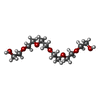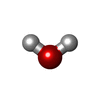[English] 日本語
 Yorodumi
Yorodumi- PDB-9m1v: Crystal structure of N-terminal domain of hypothetical protein Rv... -
+ Open data
Open data
- Basic information
Basic information
| Entry | Database: PDB / ID: 9m1v | ||||||
|---|---|---|---|---|---|---|---|
| Title | Crystal structure of N-terminal domain of hypothetical protein Rv1421 from Mycobacterium tuberculosis H37Rv in complex with uridine diphosphate N-acetyl glucosamine | ||||||
 Components Components | Nucleotide-binding protein Rv1421 | ||||||
 Keywords Keywords | HYDROLASE / Nucleotide-sugar binding protein / N-terminal domain of hypothetical protein Rv1421 / Complex with uridine diphosphate N-acetyl glucosamine | ||||||
| Function / homology |  Function and homology information Function and homology informationmolecular adaptor activity / GTP binding / ATP binding / plasma membrane Similarity search - Function | ||||||
| Biological species |  Mycobacterium tuberculosis H37Rv (bacteria) Mycobacterium tuberculosis H37Rv (bacteria) | ||||||
| Method |  X-RAY DIFFRACTION / X-RAY DIFFRACTION /  SYNCHROTRON / SYNCHROTRON /  MOLECULAR REPLACEMENT / Resolution: 1.7 Å MOLECULAR REPLACEMENT / Resolution: 1.7 Å | ||||||
 Authors Authors | Lee, K.S. / Park, J. | ||||||
| Funding support |  Korea, Republic Of, 1items Korea, Republic Of, 1items
| ||||||
 Citation Citation |  Journal: To Be Published Journal: To Be PublishedTitle: Structure-based biochemical properties of N-terminal domain of hypothetical protein Rv1421 from Mycobacterium tuberculosis H37Rv in complex with uridine diphosphate N-acetyl glucosamine Authors: Lee, K.S. / Park, J. | ||||||
| History |
|
- Structure visualization
Structure visualization
| Structure viewer | Molecule:  Molmil Molmil Jmol/JSmol Jmol/JSmol |
|---|
- Downloads & links
Downloads & links
- Download
Download
| PDBx/mmCIF format |  9m1v.cif.gz 9m1v.cif.gz | 171 KB | Display |  PDBx/mmCIF format PDBx/mmCIF format |
|---|---|---|---|---|
| PDB format |  pdb9m1v.ent.gz pdb9m1v.ent.gz | 109.1 KB | Display |  PDB format PDB format |
| PDBx/mmJSON format |  9m1v.json.gz 9m1v.json.gz | Tree view |  PDBx/mmJSON format PDBx/mmJSON format | |
| Others |  Other downloads Other downloads |
-Validation report
| Summary document |  9m1v_validation.pdf.gz 9m1v_validation.pdf.gz | 1.9 MB | Display |  wwPDB validaton report wwPDB validaton report |
|---|---|---|---|---|
| Full document |  9m1v_full_validation.pdf.gz 9m1v_full_validation.pdf.gz | 1.9 MB | Display | |
| Data in XML |  9m1v_validation.xml.gz 9m1v_validation.xml.gz | 31.7 KB | Display | |
| Data in CIF |  9m1v_validation.cif.gz 9m1v_validation.cif.gz | 42 KB | Display | |
| Arichive directory |  https://data.pdbj.org/pub/pdb/validation_reports/m1/9m1v https://data.pdbj.org/pub/pdb/validation_reports/m1/9m1v ftp://data.pdbj.org/pub/pdb/validation_reports/m1/9m1v ftp://data.pdbj.org/pub/pdb/validation_reports/m1/9m1v | HTTPS FTP |
-Related structure data
| Similar structure data | Similarity search - Function & homology  F&H Search F&H Search |
|---|
- Links
Links
- Assembly
Assembly
| Deposited unit | 
| ||||||||||||
|---|---|---|---|---|---|---|---|---|---|---|---|---|---|
| 1 | 
| ||||||||||||
| 2 | 
| ||||||||||||
| Unit cell |
|
- Components
Components
| #1: Protein | Mass: 18702.121 Da / Num. of mol.: 4 Source method: isolated from a genetically manipulated source Details: 1-14: Not found region 172-174: Not found region Source: (gene. exp.)  Mycobacterium tuberculosis H37Rv (bacteria) Mycobacterium tuberculosis H37Rv (bacteria)Gene: Rv1421, MTCY21B4.39 / Production host:  #2: Chemical | ChemComp-UD1 / #3: Chemical | ChemComp-P6G / | #4: Water | ChemComp-HOH / | Has ligand of interest | Y | Has protein modification | N | |
|---|
-Experimental details
-Experiment
| Experiment | Method:  X-RAY DIFFRACTION / Number of used crystals: 1 X-RAY DIFFRACTION / Number of used crystals: 1 |
|---|
- Sample preparation
Sample preparation
| Crystal | Density Matthews: 2.42 Å3/Da / Density % sol: 49.18 % |
|---|---|
| Crystal grow | Temperature: 294 K / Method: vapor diffusion, hanging drop Details: 0.1M MES monohydrate pH6.0, 8% (v/v) 2-propanol, 26% (w/v) PEG400 |
-Data collection
| Diffraction | Mean temperature: 100 K / Serial crystal experiment: N |
|---|---|
| Diffraction source | Source:  SYNCHROTRON / Site: PAL/PLS SYNCHROTRON / Site: PAL/PLS  / Beamline: 7A (6B, 6C1) / Wavelength: 0.9793 Å / Beamline: 7A (6B, 6C1) / Wavelength: 0.9793 Å |
| Detector | Type: DECTRIS EIGER2 S 9M / Detector: PIXEL / Date: Oct 26, 2024 |
| Radiation | Protocol: SINGLE WAVELENGTH / Monochromatic (M) / Laue (L): M / Scattering type: x-ray |
| Radiation wavelength | Wavelength: 0.9793 Å / Relative weight: 1 |
| Reflection | Resolution: 1.7→50 Å / Num. obs: 76355 / % possible obs: 98.1 % / Redundancy: 4.8 % / Biso Wilson estimate: 24.21 Å2 / CC1/2: 0.992 / CC star: 0.998 / Rmerge(I) obs: 0.121 / Net I/σ(I): 12.1 |
| Reflection shell | Resolution: 1.7→1.76 Å / Rmerge(I) obs: 0.404 / Mean I/σ(I) obs: 2.3 / Num. unique obs: 7364 / CC1/2: 0.713 / CC star: 0.912 |
- Processing
Processing
| Software |
| |||||||||||||||||||||||||||||||||||||||||||||||||||||||||||||||||||||||||||||||||||||||||||||||||||||||||
|---|---|---|---|---|---|---|---|---|---|---|---|---|---|---|---|---|---|---|---|---|---|---|---|---|---|---|---|---|---|---|---|---|---|---|---|---|---|---|---|---|---|---|---|---|---|---|---|---|---|---|---|---|---|---|---|---|---|---|---|---|---|---|---|---|---|---|---|---|---|---|---|---|---|---|---|---|---|---|---|---|---|---|---|---|---|---|---|---|---|---|---|---|---|---|---|---|---|---|---|---|---|---|---|---|---|---|
| Refinement | Method to determine structure:  MOLECULAR REPLACEMENT / Resolution: 1.7→33.01 Å / SU ML: 0.1659 / Cross valid method: FREE R-VALUE / σ(F): 1.42 / Phase error: 22.1607 MOLECULAR REPLACEMENT / Resolution: 1.7→33.01 Å / SU ML: 0.1659 / Cross valid method: FREE R-VALUE / σ(F): 1.42 / Phase error: 22.1607 Stereochemistry target values: GeoStd + Monomer Library + CDL v1.2
| |||||||||||||||||||||||||||||||||||||||||||||||||||||||||||||||||||||||||||||||||||||||||||||||||||||||||
| Solvent computation | Shrinkage radii: 0.9 Å / VDW probe radii: 1.1 Å / Solvent model: FLAT BULK SOLVENT MODEL | |||||||||||||||||||||||||||||||||||||||||||||||||||||||||||||||||||||||||||||||||||||||||||||||||||||||||
| Displacement parameters | Biso mean: 31.43 Å2 | |||||||||||||||||||||||||||||||||||||||||||||||||||||||||||||||||||||||||||||||||||||||||||||||||||||||||
| Refinement step | Cycle: LAST / Resolution: 1.7→33.01 Å
| |||||||||||||||||||||||||||||||||||||||||||||||||||||||||||||||||||||||||||||||||||||||||||||||||||||||||
| Refine LS restraints |
| |||||||||||||||||||||||||||||||||||||||||||||||||||||||||||||||||||||||||||||||||||||||||||||||||||||||||
| LS refinement shell |
|
 Movie
Movie Controller
Controller


 PDBj
PDBj




